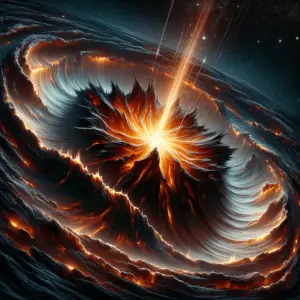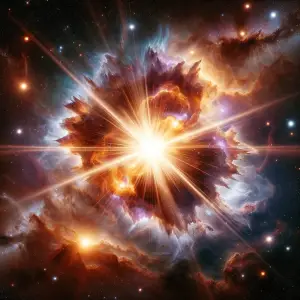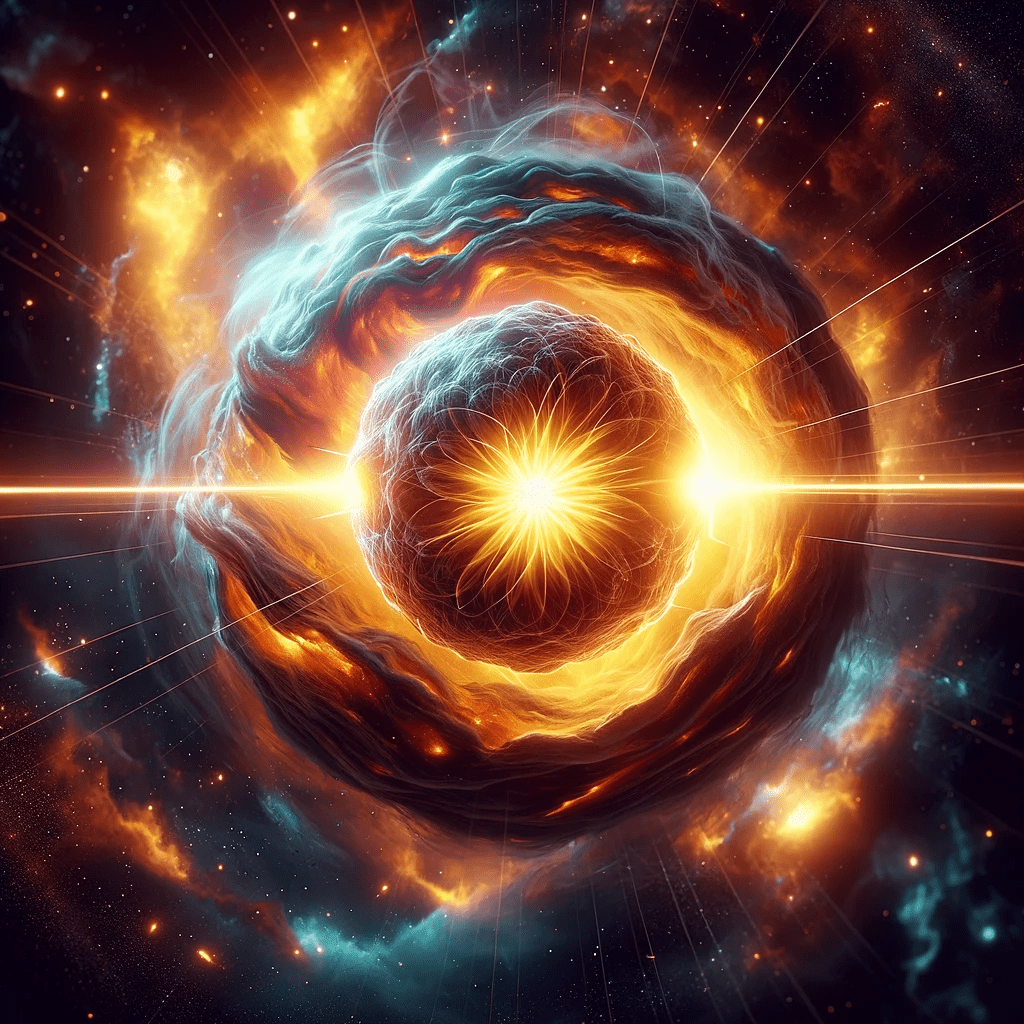In the cosmic theatre, the supernova is the ultimate spectacle—a star’s dramatic demise, outshining entire galaxies and scattering the seeds of creation.
Yet, this stellar cataclysm is more than a distant light show; it’s a fundamental force shaping our very existence.
The obliteration of a star by a supernova feels remote, but it’s intimately tied to the fabric of our being, forging elements that make up our world and even life itself.
This article unveils the intricate dance of destruction and creation, offering profound insights into the celestial phenomenon that stitches the tapestry of the cosmos.
The Mechanics of a Supernova Explosion
Gravitational Collapse and the Supernova Explosion
The cataclysmic phenomenon of a supernova explosion is a spectacular testament to the forces of nature. At the heart of this process is the gravitational collapse, where the gravitational forces play a pivotal role.
As a star depletes its nuclear fuel, the outward pressure from nuclear forces that once balanced gravity diminishes. This imbalance leads to the star’s collapse, with its core contracting under its own weight.
During this stellar implosion, the core’s density skyrockets, and temperatures soar, leading to a gravitational rebound. This rebound is not a gentle push but an explosive force that triggers the supernova explosion mechanics.
The stellar explosion is so powerful that it can outshine entire galaxies and release vast amounts of energy and newly formed elements into space.
The Role of Fusion in Supernova Explosions
The fusion of elements within a star is the powerhouse of its luminosity and life. Through the fusion process, lighter elements are combined to form heavier ones, releasing energy that provides the star with the pressure needed to counteract gravitational forces.
This delicate balance is maintained by the explosive force of nuclear fusion.
However, as a star evolves, it reaches a point where the fusion of iron is no longer energetically favourable. This cessation of fusion leads to a rapid decline in outward pressure, resulting in a gravitational collapse.
The core’s implosion halts abruptly at nuclear densities, causing a shock wave that disrupts the star and contributes to the supernova force.
The explosive fusion of elements during the supernova scatters these materials, seeding the cosmos with the building blocks for new stars and planets.
Observing Supernova Explosions
Astronomers employ a variety of tools to capture the fleeting moments of supernovae. Telescopes, both ground-based and space-borne, are the primary instruments for such astronomical observations.
They collect the light across various wavelengths, from radio to gamma rays, to construct a comprehensive picture of these stellar events.
Spectrometry is another crucial tool, allowing scientists to analyse the spectral lines of the light emitted by supernovae. This analysis reveals the elements present and the velocities at which material is expelled.
Light curve analysis, which tracks the brightness of the supernova over time, provides insights into the explosion mechanics and the nature of the progenitor star.
Through these methods, observing supernovae has become a window into the violent yet creative forces that shape our universe.
The Fate of the Star’s Core Post-Supernova
The Formation of Neutron Stars
After a supernova explosion, the fate of a star’s core is a gripping narrative of cosmic proportions. If the core’s mass is substantial but not excessive, it may undergo a dramatic transformation into a neutron star.
This process is a marvel of physics, where protons and electrons merge under extreme pressures to form neutrons, leading to an object incredibly dense yet surprisingly stable.
Neutron stars are the densest known objects that do not collapse into black holes. The stability of these star remnants is due to neutron degeneracy pressure, a quantum mechanical phenomenon that arises from the Pauli exclusion principle.
They often manifest as pulsars, emitting beams of radiation that sweep through space like cosmic lighthouses, a testament to the neutron star formation process that follows the core collapse of massive stars.
The Birth of Black Holes from Supernovae
In the grand tapestry of the cosmos, the most massive stars meet their end in a supernova, only to be reborn as black holes. This process marks a pivotal chapter in stellar evolution, where the core’s mass exceeds the Tolman–Oppenheimer–Volkoff limit, and no
known force can prevent the core from collapsing to a point of infinite density—a singularity, enshrouded within an event horizon.
The creation of black holes from supernovae is a critical mechanism through which the universe recycles matter and energy.
These supernova remnants warp space-time and often continue to accrete matter, growing in mass and influencing the dynamics of their cosmic neighborhood. The birth of a stellar black hole is a profound event, signalling the end of one stellar lifecycle and the potential beginning of another.
White Dwarfs and Supernova Explosions
Not all supernovae herald the death of massive stars; some are the dramatic finales of white dwarfs in binary systems. When a white dwarf accretes matter from its companion star and approaches the Chandrasekhar limit—approximately 1.4 times the mass of the Sun—it can no longer support the extra weight with electron degeneracy pressure.
At this juncture, the white dwarf undergoes a Type Ia supernova, a thermonuclear explosion that completely disrupts the star. Unlike the core-collapse supernovae of massive stars, this type of supernova is a spectacle of runaway nuclear fusion, where the white dwarf is incinerated in a blaze of glory.
This process not only enriches the universe with heavy elements but also serves as a cosmic measuring stick due to the uniform brightness of such explosions.

The Creation of Heavy Elements in Supernovae
Nucleosynthesis in Supernova Explosions
The cosmos is a grand tapestry woven with a variety of elements, and the process of nucleosynthesis within supernovae is pivotal in adding to this complexity.
Supernova nucleosynthesis is a theory regarding the creation and distribution of the chemical elements following a supernova explosion. It’s a phenomenon that leads to the formation of heavy elements that are essential to the universe’s makeup.
During these colossal explosions, the intense heat and pressure allow for the fusion of lighter elements into heavier ones, a process known as heavy element formation.
This is where elements heavier than iron are synthesized through rapid neutron capture by atomic nuclei. The chemical synthesis that occurs in these stellar cataclysms is responsible for producing a significant portion of the chemical abundance of elements found in the universe.
Entities such as nucleosynthesis and heavy elements are central to understanding the cosmic chemistry that shapes the universe.
The supernova yield, which refers to the amount and type of elements produced during the explosion, is crucial for the study of element creation and the subsequent chemical enrichment of the cosmos.
The Distribution of Elements by Supernovae
Supernovae not only create elements but also play a critical role in their distribution across the cosmos. The stellar debris, laden with newly formed elements, is ejected into the interstellar medium, contributing to the chemical diversity observed in space.
This process of element dispersal is a form of cosmic recycling, where the materials from one generation of stars are repurposed into new star systems.
The distribution of elements by supernovae is a key factor in the cosmic diversity we observe. It’s through this mechanism that areas of the universe become rich in certain elements, leading to a varied chemical composition across different celestial bodies and regions of space.
The supernova contribution to the chemical diversity is a testament to the dynamic and ever-evolving nature of the universe.
The Role of Supernovae in Earth’s Element Composition
The elemental composition of Earth is a direct result of the cosmic contribution of supernovae. Elements like iron, which are prevalent on our planet and even within our bodies, have their origins in the heart of these stellar explosions.
The presence of such elements is a clear indicator of the elemental makeup that supernovae have imparted to our planet.
The planetary chemistry of Earth, with its rich variety of elements, owes much to the cosmic elemental contribution of supernovae. The process of heavy element formation within these stellar events has provided the essential components for the development of planets and life as we know it.
Earth’s elements, including the iron in supernovae, are a legacy of the complex processes that govern the universe’s evolution.
In summary, supernovae are not just spectacular astronomical events but are also fundamental to the creation, distribution, and composition of elements throughout the universe.
Their role in shaping the chemical landscape of the cosmos is profound, influencing everything from the stars in the sky to the ground beneath our feet.

Supernova Remnants and Their Contribution to the Cosmos
The Structure and Composition of Supernova Remnants
When a supernova occurs, it leaves behind a tapestry of chaos and creation known as supernova remnants. These remnants, like the famed Crab Nebula, are a window into the violent events that shape our cosmos.
The Crab Nebula, for instance, is a textbook example of a supernova remnant, offering a glimpse into the nebular structure and the aftermath of such a cosmic explosion.
The composition of these remnants is a complex interplay of gases, dust, and other materials ejected at the end of a star’s life cycle.
The nebula composition is not just a chaotic aftermath; it’s a structured formation that includes everything from the dense core to the expanding shockwave front.
Supernova debris, composed of the outer layers of the star, mixes with the interstellar clouds, contributing to the rich tapestry of the interstellar medium. The structure of supernova remnants, such as the Crab Nebula, is a testament to the power and influence of these stellar events.
The Impact of Supernova Remnants on Surrounding Space
Supernova remnants are not isolated structures; they interact dynamically with their surroundings. The shock waves from these remnants can compress nearby interstellar gas, triggering the formation of new stars.
This process is a crucial aspect of the stellar birth cycle, where the death of one star can lead to the genesis of others.
The effect of supernova remnants on the interstellar medium is profound. They can influence vast regions of space, seeding future generations of stars and planetary systems.
The initiation of star birth by these remnants is a critical component of the cosmic lifecycle, ensuring the continuity of stellar evolution.
Observing and Studying Supernova Remnants
The remnants of supernovae are not just fascinating to look at; they are rich fields of study for astronomers. With advanced astronomical technology, scientists observe and analyse these remnants to piece together the history of the universe.
The methods used range from radio telescopes capturing the faint whispers of long-dead stars to space telescopes that provide a visual feast of these celestial phenomena.
The study of supernova remnants is a journey through time, offering insights into the events that have shaped the cosmos. Technological advancements in observation methods have opened new windows into this historical analysis, allowing us to understand not just where we are, but where we come from.
Observing supernova remnants is like looking at the universe’s own photo album, full of cosmic history and memories of stars long gone.
The Role of Supernovae in Star Formation
The cosmos is a grand tapestry of birth and destruction, and supernovae are among the most dramatic threads in this cosmic weave.
These stellar explosions are not just spectacular end-of-life events for stars; they are also catalysts for creation, playing a crucial role in the formation of new stars. Let’s delve into how these cataclysmic events can trigger the birth of stars, contributing to the ongoing saga of the universe.
